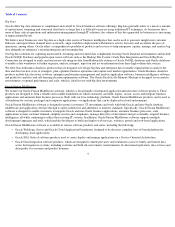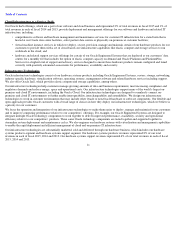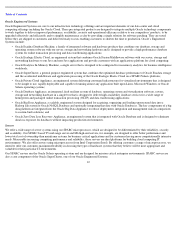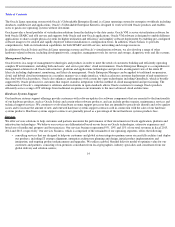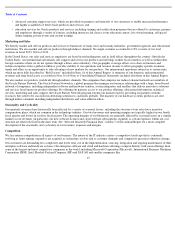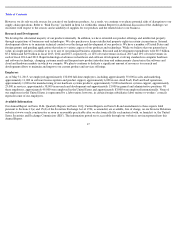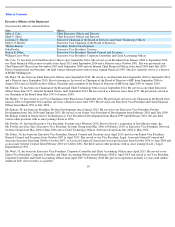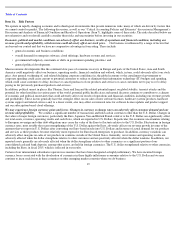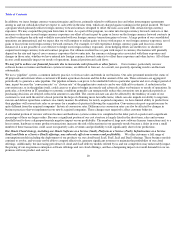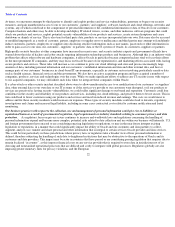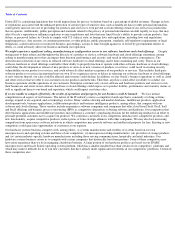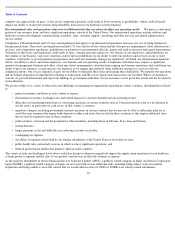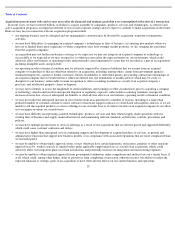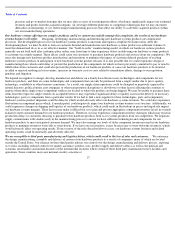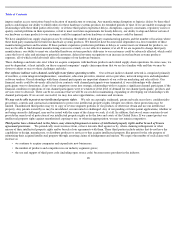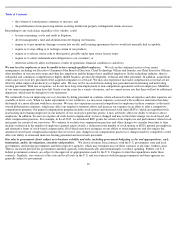Oracle 2014 Annual Report Download - page 23
Download and view the complete annual report
Please find page 23 of the 2014 Oracle annual report below. You can navigate through the pages in the report by either clicking on the pages listed below, or by using the keyword search tool below to find specific information within the annual report.
Table of Contents
Item 1A. Risk Factors
We operate in rapidly changing economic and technological environments that present numerous risks, many of which are driven by factors that
we cannot control or predict. The following discussion, as well as our “Critical Accounting Policies and Estimates” discussion in Management’s
Discussion and Analysis of Financial Condition and Results of Operations (Item 7), highlights some of these risks. The risks described below are
not exhaustive and you should carefully consider these risks and uncertainties before investing in our securities.
Economic, political and market conditions can adversely affect our business, results of operations and financial condition, including our
revenue growth and profitability, which in turn could adversely affect our stock price. Our business is influenced by a range of factors that
are beyond our control and that we have no comparative advantage in forecasting. These include:
Macroeconomic developments like the continued slow pace of economic recovery in Europe and parts of the United States, Asia and South
America could negatively affect our business, operating results, financial condition and outlook, which, in turn, could adversely affect our stock
price. Any general weakening of, and related declining corporate confidence in, the global economy or the curtailment of government or
corporate spending could cause current or potential customers to reduce or eliminate their information technology (IT) budgets and spending,
which could cause customers to delay, decrease or cancel purchases of our products and services or cause customers not to pay us or to delay
paying us for previously purchased products and services.
In addition, political unrest in places like Ukraine, Syria and Iraq and the related potential impact on global stability, terrorist attacks and the
potential for other hostilities in various parts of the world, potential public health crises and natural disasters continue to contribute to a climate
of economic and political uncertainty that could adversely affect our results of operations and financial condition, including our revenue growth
and profitability. These factors generally have the strongest effect on our sales of new software licenses, hardware systems products, hardware
systems support and related services and, to a lesser extent, also may affect our renewal rates for software license updates and product support
and our subscription-based cloud offerings.
We may experience foreign currency gains and losses. Changes in currency exchange rates can adversely affect customer demand and our
revenue and profitability. We conduct a significant number of transactions and hold cash in currencies other than the U.S. Dollar. Changes in
the values of major foreign currencies, particularly the Euro, Japanese Yen and British Pound, relative to the U.S. Dollar can significantly affect
our total assets, revenues, operating results and cash flows, which are reported in U.S. Dollars. In particular, the economic uncertainties relating
to European sovereign and other debt obligations may cause the value of the Euro to fluctuate relative to the U.S. Dollar. Fluctuations in foreign
currency rates, most notably the recent strengthening of the U.S. Dollar against the Euro, adversely affects our revenue growth in terms of the
amounts that we report in U.S. Dollars after converting our Euro-based results into U.S. Dollars and in terms of actual demand for our products
and services as these products become relatively more expensive for Euro-based enterprises to purchase. In addition, currency variations can
adversely affect margins on sales of our products in countries outside of the United States. Generally, our revenues and operating results are
adversely affected when the dollar strengthens relative to other currencies and are positively affected when the dollar weakens. In addition, our
reported assets generally are adversely affected when the dollar strengthens relative to other currencies as a significant portion of our
consolidated cash and bank deposits, among other assets, are held in foreign currencies. The U.S. dollar strengthened relative to other currencies,
including the Euro, in fiscal 2015, which is reflected in our results.
Certain of our international subsidiaries operate in economies that have been designated as highly inflationary. We have incurred foreign
currency losses associated with the devaluation of currencies in these highly inflationary economies relative to the U.S. Dollar and we may
continue to incur such losses in these countries or other emerging market countries where we do business.
19
•
general economic and business conditions;
•
overall demand for enterprise software, cloud offerings, hardware systems and services;
•
governmental budgetary constraints or shifts in government spending priorities; and
•
general political developments.


